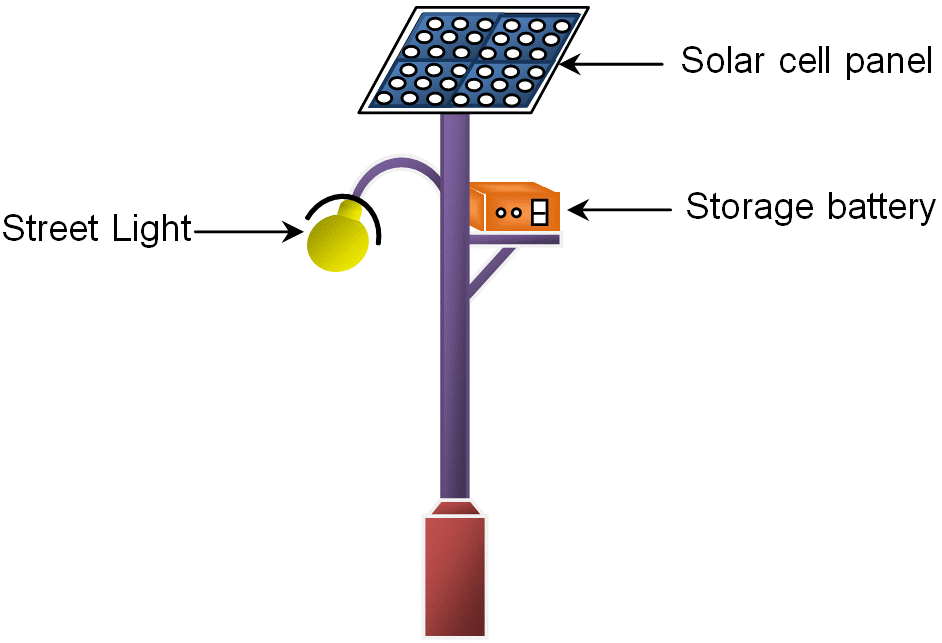Solar street lights are raised light sources which are powered by solar panels generally mounted on the lighting structure or integrated in the pole itself. The solar panels charge a rechargeable battery, which powers a fluorescent or LED lamp during the night. Most solar lights turn on and turn off automatically by sensing outdoor light using solar panel voltage. Solar streetlights are designed to work throughout the night. Many can stay lit for more than one night if the sun is not available for a couple of days. Older models included lamps that were not fluorescent or LED. Solar lights installed in windy regions are generally equipped with flat panels to better cope with the winds.

Solar street lights consist of 4 main parts:
Solar Panel
The solar panel is one of the most important parts of solar street lights, as the solar panel will convert solar energy into electricity. There are 2 types of solar panel: mono-crystalline and poly-crystalline. Conversion rate of mono-crystalline solar panel is much higher than poly-crystalline.Solar panel are varies from wattage systems.
Lighting Fixture
LED is usually used as lighting source of modern solar street light, as the LED will provide much higher Lumens with lower energy consumption. The energy consumption of LED fixture is at least 50% lower than HPS fixture which is widely used as lighting source in Traditional street lights. LEDs lack of warm up time also allows for use of motion detectors for additional efficiency gains.
Rechargeable Battery
Battery will store the electricity from solar panel during the day and provide energy to the fixture during night. The life cycle of the battery is very important to the lifetime of the light and the capacity of the battery will affect the backup days of the lights. There are usually 2 types of batteries: Gel Cell Deep Cycle Battery and Lead Acid Battery and many more. Lithium-ion batteries are also popular these days as they are compact in size and not prone to theft (cannot be used in other applications like lead acid batteries).
Pole
Strong Poles are necessary to all street lights, especially to solar street lights as there are often components mounted on the top of the pole: fixtures, panels and sometimes batteries. However, in some newer designs, the PV panels and all electronics are integrated in the pole itself. Wind resistance is also a factor.
ADVANTAGES
- Solar street lights are independent of the utility grid. Hence, the operation costs are minimized.
- Solar street lights require much less maintenance compared to conventional street lights.
- Since external wires are eliminated, risk of accidents are minimized
- This is a non polluting source of electricity
- Separate parts of solar system can be easily carried to the remote areas
- It allows the saving of energy and also cost.
DISADVANTAGES
- Initial investment is higher compared to conventional street lights.
- Risk of theft is higher as equipment costs are comparatively higher.[2]
- Snow or dust, combined with moisture can accumulate on horizontal PV-panels and reduce or even stop energy production.
- Rechargeable batteries will need to be replaced several times over the lifetime of the fixtures adding to the total lifetime cost of the light.
The charge and discharge cycles of the battery is also very important considering the overall cost of the project.
Product Details:
| Minimum Order Quantity | 1 Piece |
| Late night dimming Optional | Yes |
| Dusk to Dawn | Yes |
| Weight | 1.5 kg |
| Solar Module | 50 W |
| Battery Backup | 12v 26 AH |
| Pole Height | 15 Feet |
| Efficiency | 90% |
| Dimensions | 360 x 135 x 75 |
| Overcharge Protection | Yes |
| Lighting Type | LED |
| Warranty | 2 YEAR |
| Power Source | Sun Light, Solar |
| Lighting Color | Cool daylight |
| Solar Power | 15 Watt |
| Certification | ISI |
Integrated Solar Street Light

Product Details:
| Minimum Order Quantity | 10 Piece |
| Solar Panel | 40 W Polycrystalline |
| Dusk to Dawn | Yes |
| Battery type and Capacity | Li-Fe Po4 12.8 V & 9.9 Ah |
| Lumen Output | 1200 Lm |
| Solar charge controller rating | 10 A |
| Motion Sensor | 10 M Range |
| Efficiency | >95% ( Battery to Load ) |
| Diming | After 4 Hr Light ON and Diming to 1/3 intensity on detecting no movement for more than 30 seconds |
| LED Dispersion angle – with optics | 120 Degree |
| LED Lifetime | >50000 Hrs |
| Warranty | 5 Yrs for luminary , 25 yrs for Module |
| Color Temperature | 3000k to 6500k |
| CRI | 70-82 |
| Operating Temperature | -40 Degree to 60 Degree C |
| Light backup Time | Full night with Diming |




